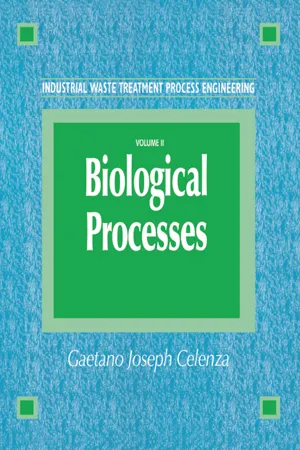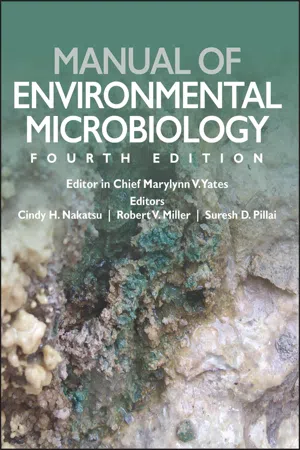Biological Sciences
Aerobic vs Anaerobic Bacteria
Aerobic bacteria require oxygen to grow and survive, using it as a final electron acceptor in their metabolic processes. In contrast, anaerobic bacteria can grow and survive in the absence of oxygen, using alternative electron acceptors such as nitrate or sulfate. This fundamental difference in oxygen requirements influences the types of environments where these bacteria can thrive.
Written by Perlego with AI-assistance
Related key terms
6 Key excerpts on "Aerobic vs Anaerobic Bacteria"
- eBook - ePub
Industrial Waste Treatment Process Engineering
Biological Processes, Volume II
- Gaetano Celenza(Author)
- 2019(Publication Date)
- CRC Press(Publisher)
Biodegradable organics are consumed by bacteria, the fastest-growing population, with the rate proportional to the available food. They can exist in an aerobic, anaerobic, or facultative environments. The bulk of bacteria is facultative, permitting them to exist in either aerobic or anaerobic conditions, allowing them to survive during oxygen-deficiency conditions. Substrate is metabolized by an enzyme produced and released by the bacteria cells, specific to the organic substrate, which accelerates the biological reaction. The ability of the cell to produce enzymes capable of reacting with the substrate is a measure of the substrate’s “biodegradability.” The bacteria are poor settling and (along with the enzyme) sensitive to environmental conditions such as temperature, pH, available oxygen, and nutrient level. Fungi are indicators of upset reactor conditions, evident by low pH, lack of oxygen, and nutrient deficiency. A dominant fungi population will compete with bacteria for soluble organics, promoting filament growth that results in poor sludge settling.Figure 2.4 Ideal growth curves (adapted from Reference [58 ]).Flagellate and amoeboid presence are indicating signs of the relative health of the biological population, indicative of low microorganism (floc) concentration and high BOD concentrations. As other organisms form, and a balanced population achieved, the flagellate concentrations diminishes. The predominance of these organisms would be evident as the system is starting up or recovering from an upset.Figure 2.5 Once through reactor.The next link in the food chain are the protozoa, which are aerobic, depending on bacteria for their survival. The most significant are the free-swimming and stalked ciliates. The more active free-swimming ciliates require and consume much of the available bacteria and are initially formed at a rate proportional to the bacteria growth. The inactive stalked ciliates form after the swimming ciliates, at a lower growth rate and resulting population, consuming smaller amounts of bacteria. The two protozoa combine to perform three important operational functions. First, because they are strictly aerobic their presence is an indication of the system viability. Next, they exist to control the bacteria population. Finally, they form a floc, and flocculating conditions, which improve sludge settling and result in high effluent quality. - eBook - ePub
- B. N. K. Davis, N. Walker, D. F. Ball, Alastair Fitter(Authors)
- 2013(Publication Date)
- Collins(Publisher)
However, it is when we turn to the study of different aspects of microbial physiology that one can appreciate their complex characteristics and behaviour, and realize what they can do and how they affect their surroundings, in this case, the soil. Free oxygen is essential for the growth and respiration of many microorganisms which, accordingly, are termed ‘aerobic’. There are many other species which can flourish only in the complete absence of gaseous oxygen. These are designated ‘anaerobic organisms’ or’anaerobes’, and in their respiration and metabolism they make use of the chemically combined oxygen present in salts such as nitrates or sulphates. Many other types of bacteria exist which, depending on conditions, can grow and function either with or without free oxygen, and these are referred to as facultative anaerobes. In their metabolism, microorganisms gain energy for growth and cell maintenance from the oxidation of different nutrients; a sugar, for example, under aerobic conditions is oxidized completely to carbon dioxide and water. On the other hand, under anaerobic conditions (i.e. absence of free oxygen) only a partial oxidation of the nutrient occurs forming carbon dioxide and water, and some incompletely oxidized substances remain in the form of intermediate oxidation products, such as alcohol and simple organic acids. The amount of energy thus mobilized is less than that theoretically possible, and therefore these anaerobic processes are distinctly less efficient than those in aerobic metabolism.FIG. 44 Electron microscope photograph of cells of a Nitrosospira species, a nitrifying bacterium isolated from an acid woodland soil – Geescroft Wilderness, Rothamsted Experimental Station. Note the long coiled spring appearance. (Photograph N. W., magnification ca. 40,000.)Temperature is also an important physical factor affecting the rate of microbial multiplication; different microbial species have different optimal growth temperatures. Some bacteria and a few fungi can grow at or near to freezing point and even exhibit their optimum growth at between 5° and 10°C; such species are termed psychrophilic and many of them are found in the sea. However, most bacterial species grow and flourish best at between 20° and 35°C and they are described as mesophilic organisms. Some microbes show optimum growth at between 45° and 50°C and there are other very specialized organisms which can grow even at 75° or 80°C. The latter are thermophilic organisms and they may be found, for example, in hot volcanic springs which often contain sulphur compounds and so represent a most extreme environment. Various bacteria and other microorganisms can tolerate and multiply in most unpromising conditions, for example in quite acid mine waters, and there are others which exist in alkaline environments, with or without free oxygen and often utilizing very unusual nutrients.FIG. 45 - eBook - ePub
- Jane E. Sykes(Author)
- 2013(Publication Date)
- Saunders(Publisher)
Chapter 37Anaerobic Bacterial Infections
Jane E. SykesOverview of Anaerobic Bacterial InfectionsFirst Described: 1860s (Louis Pasteur)1Causes: Bacteroides, Prevotella, Porphyromonas, Peptostreptococcus, Fusobacterium, Clostridium, Propionibacterium, other speciesGeographic Distribution: Worldwide Mode of Transmission: Direct contact, and opportunistic invasion of tissues by commensal bacteria Major Clinical Signs: Abscess formation in a variety of tissues, pyothorax, peritonitis, pyometra, periodontal disease, osteomyelitis, bacteremia Differential Diagnoses: Primarily bacterial infections caused by gram-positive and gram-negative aerobes, but also neoplasia (when discrete abscessation is present).Human Health Significance: Anaerobes of the oral cavities of dogs and cats are an important component of animal bite wound infections in humans. Enteric clostridial infections of dogs and cats may also have public health significance (see Chapter 48 ).Etiology and Epidemiology
An anaerobe is an organism that requires an environment that is reduced in oxygen for growth and does not grow in air. Anaerobic bacteria represent a significant component of the normal flora of the upper and lower gastrointestinal tracts of dogs and cats as well as their genital tracts; in addition, anaerobes play an important role in the regulation of the bacterial composition of the normal flora. Aerobes and facultative organisms that reside alongside anaerobes use oxygen present in these sites and reduce the local oxidation-reduction potential, which permits survival and growth of anaerobes. Sites that are protected from oxygen such as the gingival crevices also favor anaerobes. The metabolic activity of anaerobic bacteria prevents colonization of mucosal surfaces by potentially more pathogenic microbes (this is known as colonization resistance - eBook - ePub
- Cindy H. Nakatsu, Robert V. Miller, Suresh D. Pillai(Authors)
- 2016(Publication Date)
- ASM Press(Publisher)
Anaerobic Cultivation TAKASHI NARIHIRO AND YOICHI KAMAGATA 2.1.2Anaerobes are key players in global cycles of elements and nutrition in natural and anthropologic ecosystems and are also causative agents of human and veterinary diseases. Numerous studies have sought to develop culturing techniques for anaerobes to enable the elucidation of their basic physiology, pathogenic mechanisms, and ecological functions. This chapter describes a brief history of the development of anaerobic culturing techniques from the historical Hungate technique to techniques and apparatuses commonly used in modern laboratories. In addition, recent progress in anaerobic culturing techniques (e.g., single-cell manipulation and isolation, the six-well plating method, the coculture method, bioreactor-based enrichment, and in situ /in vivo cultivation) are described, with several examples of the application of these techniques for the isolation of anaerobes from natural and artificial ecosystems.Anaerobic microorganisms (hereafter designated anaerobes) are key players in global cycles of elements (e.g., carbon, nitrogen, sulfur, and iron) in natural and anthropogenic ecosystems, including aquifer/groundwater (1 ), animal/insect guts (2 , 3 ), rice paddy fields (4 ), rumen (5 ), terrestrial/oceanic subsurfaces (6 , 7 ), wetlands (8 ), biodiesel production processes (9 ), food production processes (10 ), and wastewater treatment processes (11 ). In these anoxic ecosystems, various metabolic groups of anaerobes play roles in specific biochemical reactions, such as fermentation (12 , 13 ), anaerobic ammonium oxidation (anammox) (14 ), sulfate reduction (15 ), iron reduction (16 ), syntrophic substrate oxidation (17 ), and methanogenesis (18 ). In addition to these metabolic groups, anaerobes include human and animal pathogens, which were the main focus in the earliest era of modern microbiology. The challenges of cultivating, characterizing, and controlling these anaerobic pathogens organisms spurred the establishment of modernized microbiology (19 –23 - eBook - ePub
- Stephen P. Denyer, Norman A. Hodges, Sean P. Gorman, Brendan F. Gilmore(Authors)
- 2011(Publication Date)
- Wiley-Blackwell(Publisher)
There are marked similarities in the metabolic pathways used by pathogenic bacteria and by mammals. Many bacteria use the same process of glycolysis that is used by humans to begin the breakdown of glucose and the release of energy from it. Glycolysis describes the conversion of glucose, through a series of reactions, to pyruvic acid, and it is a process for which oxygen is not required, although glycolysis is undertaken by both aerobic and anaerobic organisms. The process releases only a relatively small amount of the energy stored in a sugar molecule, and aerobic microorganisms, in common with mammals, release much more of the energy by aerobic respiration. Oxygen is the molecule at the end of the sequence of respiratory reactions that finally accepts the electrons and allows the whole process to proceed, but it is worth noting that many organisms can also undertake anaerobic respiration, which uses other final electron acceptors, e.g. nitrate or fumarate.As an alternative to respiration many microorganisms use fermentation as a means of releasing more energy from sugar; fermentation is, by definition, a process in which the final electron acceptor is an organic molecule. The term is widely understood to mean the production by yeast of ethanol and carbon dioxide from sugar, but in fact many organisms apart from yeasts can undertake fermentation and the process is not restricted to common sugar (sucrose) as a starting material or to ethanol and carbon dioxide as metabolic products. Many pathogenic bacteria are capable of fermenting several different sugars and other organic materials to give a range of metabolic products that includes acids (e.g. lactic, acetic and propionic), alcohols (e.g. ethanol, propanol, butanediol) and other commercially important materials like the solvents acetone and butanol. Fermentation is, like glycolysis, an anaerobic process, although the term is commonly used in the pharmaceutical and biotechnology industries to describe the manufacture of a wide rang of substances by microorganisms where the biochemical process is neither fermentative nor even anaerobic, e.g. many textbooks refer to antibiotic fermentation, but the production vessels are usually vigorously aerated. - Randall T. Hayden, Karen C. Carroll, Yi-Wei Tang, Donna M. Wolk(Authors)
- 2016(Publication Date)
- ASM Press(Publisher)
120 Selected Topics in Anaerobic Bacteriology
INTRODUCTION
A diverse community makes up the normal healthy microbiota in humans, and anaerobic bacteria are the primary component (1 –4 ). A wide variety of different environments in the human body support complex microbial communities comprising both obligate and facultative anaerobes (3 , 4 ). At all body sites where anaerobes are part of the indigenous microbiota, obligate anaerobes greatly outnumber facultative anaerobes by a factor of 10 up to 1,000 times (Table 1 ) (5 –9 ). Obligate anaerobes are therefore the predominant type of bacteria present in humans at skin and mucosal surfaces. Microbial-community analysis of healthy human intestinal microbiota also reveals a rich and diverse array of anaerobes including Lactobacillus spp., members of the former Bacteroides fragilis group (i.e., B. fragilis, B. distasonis, B. thetaiotaomicron , B. ovatus , and B. vulgatus ), other Bacteroides species, and Clostridium spp., as well as a wide array of anaerobes that are less clinically encountered (2 , 10 , 11 ). Under normal circumstances, intestinal anaerobes are not pathogenic but are essential for preventing overgrowth of opportunistic organisms or infection with pathogenic bacteria. Colonization resistance against acquisition of enteric pathogens (i.e., Salmonella and Shigella ) and hospital-acquired antibiotic-resistant bacteria (e.g., vancomycin-resistant enterococci and Clostridium difficile ) is provided by the presence of healthy normal bacteria that prevent gastrointestinal colonization by exogenous bacteria (1 , 10 , 12 –18 ).Table 1 Diversity of anaerobes in the human bodya, ba See references 5 –9 .b CFU, colony-forming units; GI, gastrointestinal.Recent microbiome studies document clearly that maintenance of the integrity of the intestinal microbiome is essential to health. These microbial communities have important immunomodulatory effects on the development and regulation of host immune function, as well as contributing to the host’s nutrition by providing nutrients and vitamins to cells (1 , 2 , 4 , 11
Learn about this page
Index pages curate the most relevant extracts from our library of academic textbooks. They’ve been created using an in-house natural language model (NLM), each adding context and meaning to key research topics.





